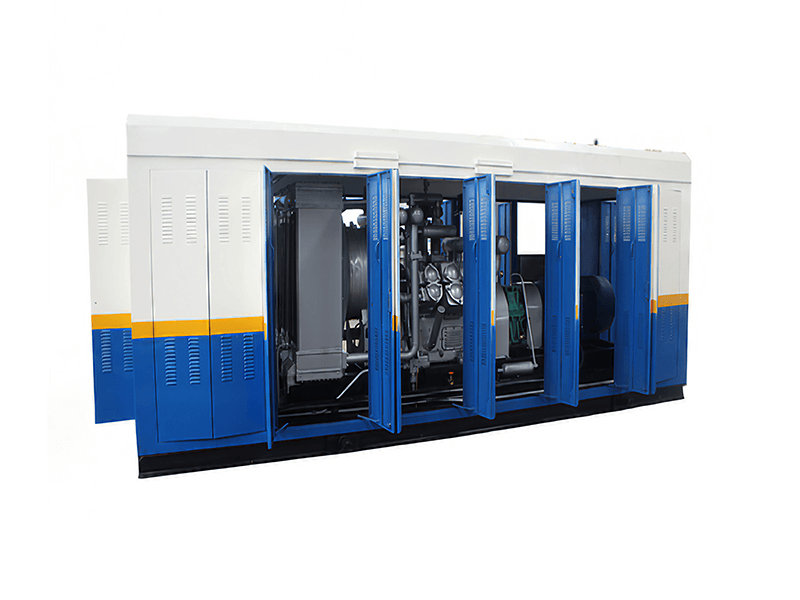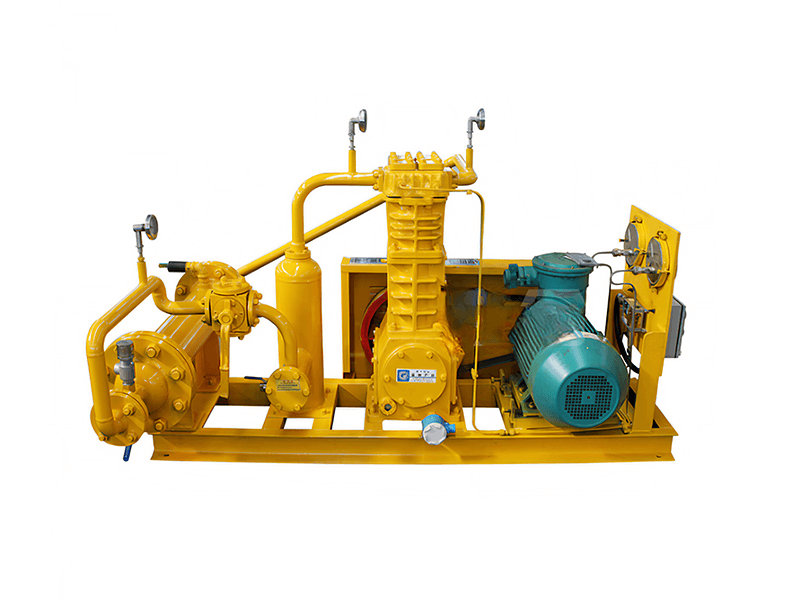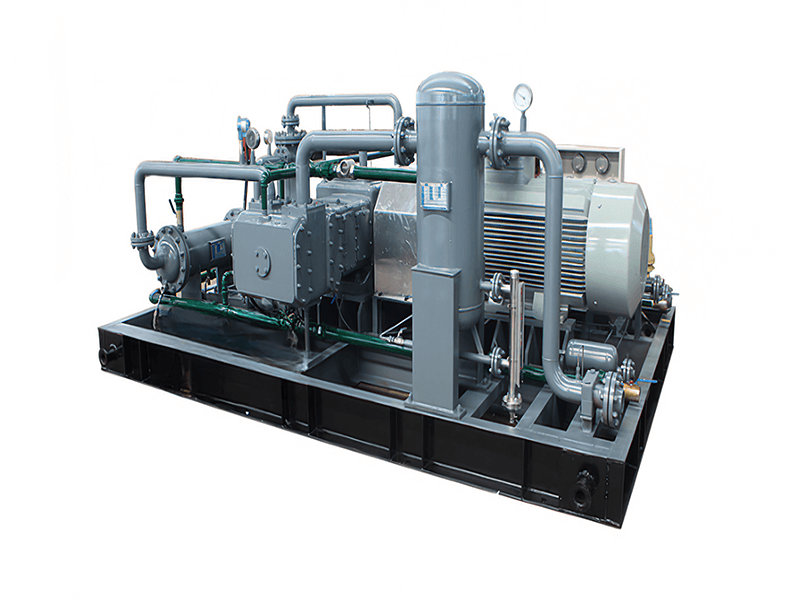Common faults that can occur in hydrogen compressors include:
1. Leakage: Compressors can experience leaks in various components such as seals, gaskets, valves, or connections. Hydrogen gas is highly flammable and can pose safety risks if there are leaks in the system.
2. Mechanical Failure: Components such as pistons, cylinders, diaphragms, screws, or impellers can experience mechanical failures due to wear and tear, fatigue, or inadequate maintenance. This can lead to reduced compression efficiency, loss of pressure, or complete breakdown of the hydrogen compressor.
3. Overheating: Compressors can overheat due to factors such as insufficient cooling, inadequate lubrication, high ambient temperatures, or prolonged operation at high pressures. Overheating can cause damage to compressor components and lead to decreased performance or even system failure.
4. Contamination: Hydrogen compressors can be susceptible to contamination from foreign particles, moisture, or oil. Contamination can affect the quality and purity of the compressed hydrogen gas, leading to performance issues or damage to downstream equipment.
5. Vibration and Noise: Excessive vibration or noise can indicate faults such as misalignment, unbalanced rotating parts, worn bearings, or loose components. These issues can cause further damage, reduced efficiency, or safety hazards.
6. Pressure Regulation Issues: Compressors may experience problems with pressure regulation, such as inability to maintain desired pressure levels, pressure fluctuations, or failure to reach target pressures. This can be due to issues with control valves, pressure sensors, or malfunctioning pressure regulation systems.
7. Electrical or Control System Failures: Compressors with electrical or control systems can experience faults such as sensor failures, faulty wiring, malfunctioning control panels, or software glitches. These issues can disrupt compressor operation and affect performance.

8. Lubrication Problems: Compressors that require lubrication can encounter issues such as inadequate lubrication, oil contamination, or failure of lubrication systems. Improper lubrication can lead to increased friction, wear, and potential damage to compressor components.
9. Corrosion: Corrosion can occur in compressor components exposed to hydrogen gas. It can lead to deterioration of materials, reduced performance, leaks, or structural failures if not addressed promptly.
10. Inadequate Maintenance: Lack of proper maintenance, including regular inspections, lubrication, cleaning, and component replacements, can contribute to various faults and decrease the overall reliability and lifespan of the compressor.
11. Valve Sticking: Valves within the compressor can stick due to contamination, inadequate lubrication, or wear and tear. Sticking valves can result in reduced efficiency, loss of pressure, or even complete compressor failure.
12. Bearing Failure: Bearings support the rotating components of the compressor, and when they fail due to wear, inadequate lubrication, or contamination, it can lead to increased friction, excessive vibration, and potential damage to other parts of the compressor.
13. Control System Malfunction: The control system of the compressor, including sensors, actuators, and control panels, can experience malfunctions due to electronic or mechanical issues. This can result in improper operation, failure to maintain desired pressure or flow levels, or incorrect system shutdown.
14. Clogging of Filters: Compressors often have filters to remove contaminants from the incoming gas. If these filters become clogged or saturated with contaminants, it can restrict the flow, increase pressure drop, and impact compressor performance.
15. Inadequate Cooling: Compressors generate heat during operation, and if the cooling system is inadequate or compromised, it can lead to overheating, reduced efficiency, and potential damage to compressor components.
16. Inadequate Lubrication: Insufficient or improper lubrication can lead to increased friction, wear, and premature failure of compressor parts. It's important to follow the manufacturer's recommendations for lubrication and ensure proper maintenance of the lubrication system.
17. Electrical Power Issues: Compressors that rely on electrical power can experience faults such as power surges, voltage fluctuations, or electrical component failures. These issues can disrupt compressor operation, cause damage, or lead to unexpected shutdowns.
18. Instrumentation and Control Calibration: Faulty calibration of pressure sensors, temperature sensors, or other instrumentation can result in inaccuracies in pressure or temperature readings, potentially leading to incorrect operation or system instability.
19. Sealing Problems: Faulty seals or gaskets can result in leaks, leading to gas loss, reduced efficiency, and safety hazards associated with hydrogen gas.
20. Wear and Tear: Over time, normal wear and tear can occur in various parts of the compressor, including seals, bearings, valves, and pistons. Regular inspection and maintenance are necessary to identify and address signs of wear before they lead to significant faults.
Addressing these faults promptly through regular maintenance, inspection, and troubleshooting is crucial for the safe and efficient operation of hydrogen compressors. It's recommended to consult the manufacturer's guidelines and engage qualified professionals for maintenance and repair tasks to ensure the reliability and longevity of the compressor system.
Handling methods for common faults in hydrogen compressor can vary depending on the specific issue. Here are some general guidelines for addressing common faults:
1. Leakage:
- Identify the source of the leak using methods such as visual inspection, pressure testing, or the use of leak detection equipment.
- Repair or replace faulty seals, gaskets, valves, or connections.
- Ensure proper tightening or sealing of components to prevent further leaks.
- Conduct leak tests to verify the effectiveness of repairs and ensure the system is free from leaks.
2. Mechanical Failure:
- Identify the specific component(s) experiencing mechanical failure through inspection, diagnostic tests, or monitoring of performance.
- Repair or replace the damaged or worn-out component(s) following manufacturer guidelines.
- Conduct proper alignment, balancing, and installation of replacement parts.
- Perform regular maintenance tasks such as lubrication, cleaning, and inspection to prevent future mechanical failures.
3. Overheating:
- Check the cooling system for proper operation, including fans, radiators, heat exchangers, or cooling water circulation.
- Ensure an adequate supply of cooling water or cooling medium.
- Address any blockages or restrictions in the cooling system to improve heat dissipation.
- Verify proper lubrication and adjust lubrication levels if needed.
- Monitor operating temperatures and implement temperature control measures if necessary, such as adjusting operating parameters or reducing workload.
4. Contamination:
- Implement proper filtration systems to remove contaminants from the hydrogen gas.
- Monitor and maintain the filtration system to ensure its effectiveness.
- Regularly inspect and clean filters or replace them as recommended by the manufacturer.
- Address any sources of contamination, such as oil carryover, moisture ingress, or foreign particles, by identifying and rectifying the root cause.
5. Vibration and Noise:
- Identify the source of excessive vibration or noise through inspection and diagnostics.
- Tighten loose components, such as bolts or fasteners, to reduce vibration.
- Balance rotating parts, such as impellers or screws, to minimize vibration.
- Replace or repair damaged bearings or other components contributing to vibration.
- Install vibration dampening measures, such as isolators or vibration-absorbing materials, if necessary.
6. Pressure Regulation Issues:
- Inspect and calibrate pressure sensors or switches to ensure accurate readings.
- Verify the functioning of control valves and actuators.
- Check the control system for faults, such as faulty wiring or malfunctioning control panels.
- Make necessary adjustments to the pressure regulation system to maintain desired pressure levels.
- Consider upgrading or replacing pressure regulation components if they are consistently unable to meet requirements.
7. Electrical or Control System Failures:
- Inspect electrical connections, wiring, and components for damage or faults.
- Test and replace faulty sensors, actuators, or control panels.
- Verify proper grounding and electrical supply to the compressor.
- Troubleshoot control system software or programming issues if applicable.
- Consult qualified technicians or electricians for complex electrical or control system repairs.
8. Lubrication Problems:
- Ensure the compressor is using the correct type and grade of lubricant as recommended by the manufacturer.
- Verify the lubrication system for proper operation, including oil levels and flow rates.
- Clean or replace clogged or contaminated lubrication filters.
- Inspect and repair any leaks or faults in the lubrication system.
- Follow recommended lubrication maintenance schedules and procedures.
9. Corrosion:
- Inspect compressor components for signs of corrosion.
- Implement corrosion prevention measures, such as protective coatings or materials resistant to hydrogen corrosion.
- Regularly clean and inspect components exposed to hydrogen gas to remove corrosion-inducing contaminants.
- Address any issues with moisture ingress or improper sealing that can contribute to corrosion.
- Monitor and maintain proper environmental conditions to mitigate corrosion risks.
10. Inadequate Maintenance:
- Establish a regular maintenance schedule based on the manufacturer's recommendations.
- Conduct routine inspections, lubrication, cleaning, and component replacements as specified.
- Keep comprehensive maintenance records to track the history and condition of the compressor.
- Train personnel on proper maintenance procedures and safety protocols.
- Engage qualified technicians or service providers for maintenance tasks beyond routine inspections and basic maintenance.
11. Valve Sticking:
- Inspect and clean valves to remove any contaminants or debris causing sticking.
- Lubricate valves with appropriate lubricants to ensure smooth operation.
- Replace damaged or worn-out valve components.
- Verify proper alignment and seating of valves.
- Conduct regular maintenance and cleaning to prevent valve sticking.
12. Bearing Failure:
- Identify the cause of bearing failure, such as inadequate lubrication or contamination.
- Replace damaged or worn-out bearings with proper replacements.
- Ensure proper lubrication by following manufacturer guidelines.
- Inspect and address any underlying issues, such as misalignment or excessive vibration, that may contribute to bearing failure.
- Monitor bearing condition regularly and perform timely maintenance or replacement as required.
13. Control System Malfunction:
- Troubleshoot the control system to identify the root cause of the malfunction.
- Inspect and test sensors, actuators, and control panels for faults or damage.
- Repair or replace malfunctioning control system components.
- Calibrate sensors and adjust control parameters as needed.
- Ensure proper electrical connections and power supply to the control system.
14. Clogging of Filters:
- Monitor filter condition and pressure differentials to detect clogging.
- Clean or replace clogged filters according to manufacturer recommendations.
- Install proper filtration systems to prevent excessive contamination and clogging.
- Regularly inspect and maintain filters to prevent a buildup of contaminants.
- Consider implementing additional filtration stages or upgrading filtration systems if frequent clogging occurs.
15. Inadequate Cooling:
- Inspect cooling system components such as fans, radiators, or heat exchangers for damage or blockages.
- Clean or repair cooling system components to ensure proper airflow or heat transfer.
- Verify the flow and quality of cooling water or cooling medium.
- Optimize cooling system settings or consider installing additional cooling capacity if needed.
- Monitor operating temperatures closely and take appropriate measures to prevent overheating.
16. Inadequate Lubrication:
- Verify lubrication system functionality, including oil levels, flow rates, and pressure.
- Adjust lubrication levels or replace lubricant as per manufacturer guidelines.
- Inspect and maintain lubrication system components such as filters, pumps, and lines.
- Address any leaks or faults in the lubrication system promptly.
- Train personnel on proper lubrication procedures and follow recommended maintenance schedules.
17. Electrical Power Issues:
- Inspect electrical connections, wiring, and circuitry for damage, loose connections, or corrosion.
- Address any power supply issues, such as voltage fluctuations or inadequate capacity.
- Install surge protection devices to safeguard the compressor from power surges.
- Test electrical components and replace any faulty or damaged parts.
- Engage qualified electricians or technicians to handle complex electrical issues.
18. Instrumentation and Control Calibration:
- Calibrate pressure sensors, temperature sensors, and other instrumentation regularly.
- Follow manufacturer guidelines for calibration procedures and intervals.
- Verify the accuracy of readings through comparison with known standards.
- Adjust control parameters based on calibrated measurements.
- Document calibration activities for future reference and compliance.
19. Sealing Problems:
- Inspect seals and gaskets for damage, wear, or improper installation.
- Replace faulty seals or gaskets with suitable replacements.
- Ensure proper alignment and seating of seals and gaskets.
- Use compatible sealing materials that are resistant to hydrogen gas.
- Conduct leak tests after seal replacements or repairs to verify effectiveness.
20. Wear and Tear:
- Conduct regular inspections to identify signs of wear and tear.
- Replace worn-out or damaged components before they lead to major faults.
- Follow manufacturer guidelines for component replacements and maintenance intervals.
- Keep comprehensive maintenance records to track component lifespan and replacement history.
- Implement preventive maintenance practices, such as lubrication, cleaning, and alignment checks, to minimize wear and tear.
Remember, handling methods may vary depending on the specific compressor model and manufacturer guidelines. It's crucial to consult the manufacturer's documentation and seek assistance from qualified professionals when dealing with complex faults or issues related to hydrogen compressors.


























